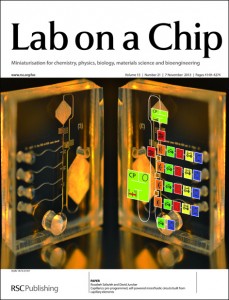The term ‘microfluidics’ immediately invokes the image of elegant, tiny devices with a small footprint in which fluids are manipulated with ease. It is an image that is most definitely correct. Still, every researcher in the field of microfluidics is aware of ‘the dirty little secret’ of these devices. Namely, that they often require bulky pumps and lots of tubing to be operated.
The requirement for macroscopic equipment to control microfluidic devices is a serious problem. It hinders the development of complex and integrated microfluidic circuits and it prevents the integration of the devices in small portable equipment.

Many researchers in the field are actively developing methods to get rid of all macroscopic equipment to control microfluidic devices. One such method is to build ‘autonomous’ devices, in which the flow is driven only by capillary forces and not by external pumps.
In a recent paper, which featured as the Cover article for Issue 21 of Lab on a Chip, Safavieh and Juncker give a solid overview of the various elements that can be used to autonomously control flow, such as pumps, vents and valves. Moreover, they propose a method called ‘capillarics’ in which autonomous fluidic circuits are designed in a way that is similar to electronic circuits. Finally, they demonstrate the power of their approach by rationally designing a ‘capillaric circuit’ and using it to perform a biochemical assay.
To learn more, read the full HOT article: Capillarics: pre-programmed, self-powered microfluidics circuits built from capillary elements, Roozbeh Safavieh and David Juncker, DOI: 10.1039/C3LC50691F










